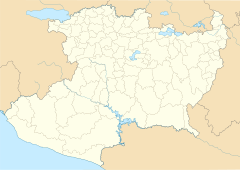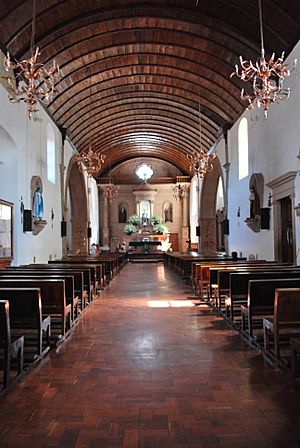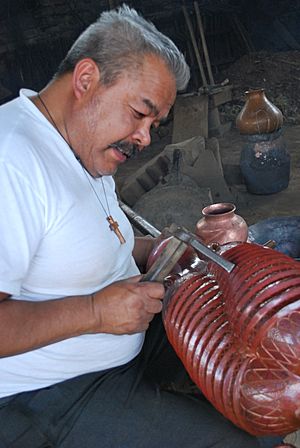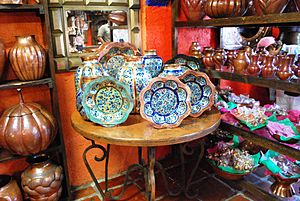Santa Clara del Cobre facts for kids
Quick facts for kids
Santa Clara del Cobre
|
|
|---|---|
|
Town and Municipality
|
|
| Salvador Escalante | |

Plaza of Santa Clara del Cobre
|
|
| Country | |
| State | Michoacán |
| Founded | 1521 |
| Area | |
| • Municipality | 487.98 km2 (188.41 sq mi) |
| Elevation
(of seat)
|
2,200 m (7,200 ft) |
| Population
(2005) Municipality
|
|
| • Municipality | 38,502 |
| • Seat | 13,069 |
| Time zone | UTC-6 (Central (US Central)) |
| • Summer (DST) | UTC-5 (Central) |
Santa Clara del Cobre (pronounced "SAN-tah KLAH-rah del KOH-bray") is a special "Pueblo Mágico" (Magical Town) in the state of Michoacán, Mexico. It is located in the central part of the state, about 18 kilometers from Pátzcuaro. Even though the official name for the area is Salvador Escalante, most people call both the town and the wider area Santa Clara del Cobre. This town is famous for its amazing copper crafts.
The people who live here are mostly from the Purépecha people. They have been working with copper for a very long time, even before the Spanish arrived. This tradition made the town a major center for copper crafts during the time of New Spain (1519–1821). After some tough times, efforts in the 1940s and 1970s helped bring the town's copper work back to fame. Santa Clara del Cobre was officially named a "Pueblo Mágico" in 2010.
Contents
History of Santa Clara del Cobre
Early Purépecha Copper Work
The area around Lake Pátzcuaro was settled by the Purépecha people starting in the 1100s. They built villages like Xacuaro near where Santa Clara del Cobre is today. The Purépecha were very skilled at working with copper. They were one of the few ancient cultures in Mexico, along with the Zapotec in Oaxaca, who used copper widely.
The Purépecha were the best metalworkers in their time. They could make bells, decorations, jewelry, and tools like axes from copper. They even knew how to add gold to their copper items. Old burial sites in the area have shown copper axes, masks, and tools. This was partly because there were rich copper mines nearby, which also attracted the Spanish later on.
Spanish Arrival and New Techniques
When the Spanish first arrived, many native people ran away. But the Spanish soon encouraged them to come back and continue their crafts. Vasco de Quiroga, a Spanish bishop, helped the people of Santa Clara. He gave them the special right to make "cazos," which are large cooking pots. These pots are still used in Mexico today for cooking. He also taught them new ways to melt and shape copper. The town was founded as Santa Clara de Acuero in 1521.
Growth of Copper Production
In 1540, a large workshop was built in Santa Clara to melt copper. The copper came from mines far away, but it was melted here because the process needed a lot of charcoal. The forests around the town provided all the wood needed for charcoal. The town was officially named Santa Clara de los Cobres in 1553.
Santa Clara became the most important place for copper work in New Spain. It made many items like cauldrons, church bells, and even sent copper to be made into coins. In 1765, two nearby native villages joined with Santa Clara de los Cobres. Miguel Hidalgo y Costilla, a famous Mexican independence leader, worked at the local church in 1788. The town was officially recognized in 1858 and called Santa Clara de Portugal.
Challenges and Revival
Copper production was at its highest in the late 1800s. But then, a huge fire destroyed the town, and it became very poor. Another fire in 1910 caused many Spanish residents to leave. The town's copper tradition was almost forgotten.
In 1932, the town's name was changed to Villa Escalante, and the wider area became Salvador Escalante. However, people still preferred to call it Santa Clara del Cobre. In 1946, local artists started a copper fair, which still happens every year. This helped bring the copper industry back to life, with people making beautiful jugs, vases, and other items.
Today, the copper used in Santa Clara comes from recycled wires and cables. In 1981, the town officially changed its name back to Santa Clara del Cobre, but the municipality kept the name Salvador Escalante.
Exploring the Town
Santa Clara del Cobre has kept its old-fashioned look. Most houses and buildings are painted white with red tile roofs. Older buildings have thick walls made of adobe (a type of mud brick). Many homes have copper decorations like bells, flowerpots, and doorknockers.
The town center has two main plazas. One plaza has a special kiosk with a copper roof. The benches and trash cans around it are also decorated to look like copper. Many shops selling copper goods face this plaza. Next to it is a simpler plaza, where you can find the town's two main churches: the Parish of Santa Clara and the Chapel del Hospital.
Copper Museum
Near the kiosk plaza is the Museo del Cobre (Copper Museum). This museum displays many hand-hammered copper items. You can see pieces from ancient times, as well as winning artworks from the town's yearly copper festival. One part of the museum has workshops where people can learn about coppersmithing. It's also home to the Artisans’ Union, which helps keep the craft alive and growing.
Coppersmithing in Santa Clara del Cobre
People in this area have been working with copper since before the Spanish arrived. The native Purépecha were very skilled metalworkers. Even though the Spanish brought new methods, some native techniques, like smelting, were kept because they worked better.
Most people in Santa Clara del Cobre, about 82%, work in copper. There are around 250 workshops in and near the town. They process about 450 tons of copper each year, which brings in a lot of money. Many copper items are useful for daily life, like cooking pots, containers, plates, and even furniture. Since the 1970s, artists have also started making copper jewelry and other decorative items.
Most workshops are family-owned. Children learn the craft from their parents. There is also a special school called Vasco de Quiroga that teaches coppersmithing.
Making a copper piece can take from four days to a month, depending on its size and how detailed it is. For example, the copper roof of the town's kiosk took a lot of work! Making a piece usually needs four people to heat the metal, turn it, and hammer it into shape.
Copper items from Santa Clara del Cobre are now collected by museums and private collectors around the world. This has helped the town export more of its beautiful crafts. Special art shows, like "Santa Clara del Cobre. Obras Maestras" (Santa Clara del Cobre Masterpieces), have been held to show off the town's amazing work and history.
Modern Influences on Copper Work
Since the 1970s, American artist James Metcalf and his wife, Mexican artist Ana Pellicer, have greatly helped the copper craft in Santa Clara del Cobre. They were both famous artists before they moved to the town. Metcalf even designed the Olympic torch for the 1968 Summer Olympics, and Pellicer designed jewelry for the Statue of Liberty's 100th birthday.
They opened a studio in Santa Clara, bringing new ideas for working with copper. In 1972, they started the Casa de Artesana, which brought artisans together. They created huge public art pieces, like murals, that are now in places like the Acapulco Convention Center. These artworks helped bring a lot of attention to the town's copper craft.
Before this, women usually didn't make copper items because it required a lot of strength. Pellicer introduced copper jewelry making, allowing women to create delicate chains and small beads. The couple also brought in new tools and techniques, mixing them with traditional designs.
With government help, Metcalf and Pellicer opened an arts and crafts school in 1976. This school teaches new techniques and artistic skills. It grew into the Adolfo Best Maugard Center for Creative Technical and Industrial Training (CECATI No. 166). It now teaches students from all over Mexico and has other campuses in places like Guanajuato and Oaxaca.
Feria del Cobre (Copper Festival)
The Feria Nacional y Concurso del Cobre Martillado (National Festival and Competition of Hammered Copper) happens in late August or early September. It's held around the feast day of the town's patron saint, Saint Clare (Santa Clara). This festival is one reason why Michoacán is known for its excellent crafts.
The main part of the festival is a copper crafts competition. It gives out many prizes, totaling about 400,000 pesos. The festival starts with speeches and a parade. The parade has floats with themes about copper and local farming. Other fun activities include music, dances, singing contests, sports, classic car shows, fireworks, and food tasting. Local foods you might try are sopa rellena, tostadas de carne Apache, corundas, and atole. A festival queen is also crowned each year.
The Municipality of Salvador Escalante
The town of Santa Clara del Cobre is the main center for the wider area, which is called the municipality of Salvador Escalante. This municipality includes 116 smaller communities. About one-third of the total population of 38,502 people live in the town of Santa Clara del Cobre itself.
The municipality is in central Michoacán and covers an area of 487.98 square kilometers. It is part of the Trans-Mexican Volcanic Belt, with mountains like Santa Clara and San Miguel. The main rivers are Silencio and Manzanillos. There's also Lake Zirahuén, which is a beautiful deep blue lake surrounded by pine forests. The area has a mild climate with a rainy summer. You can find pine and oak forests, and some tropical plants in lower areas. Animals like opossums, foxes, and rabbits live here, and trout can be found in the rivers and Lake Zirahuén. The beautiful scenery of the municipality was even featured in a famous novel called “La vida inútil de Pito Pérez.”
Economy and Crafts
Copper smithing is the most important economic activity, especially in the main town. However, farming uses most of the land in the municipality. Farmers grow crops like corn, potatoes, wheat, beans, and blackberries. They also raise animals such as cattle, pigs, and horses. Other industries include food processing and woodworking, especially making furniture.
Tourism is also important, thanks to the copper crafts, the annual festival, and the natural beauty of the forests and Lake Zirahuén. Other crafts are made in communities outside the main town. For example, communities like Opopeo make chairs, rag dolls, and wooden items. Many of these artisans get support from the Mexican government through the Fondo Nacional para el Fomento de las Artesanías.
See also
 In Spanish: Santa Clara del Cobre para niños
In Spanish: Santa Clara del Cobre para niños






